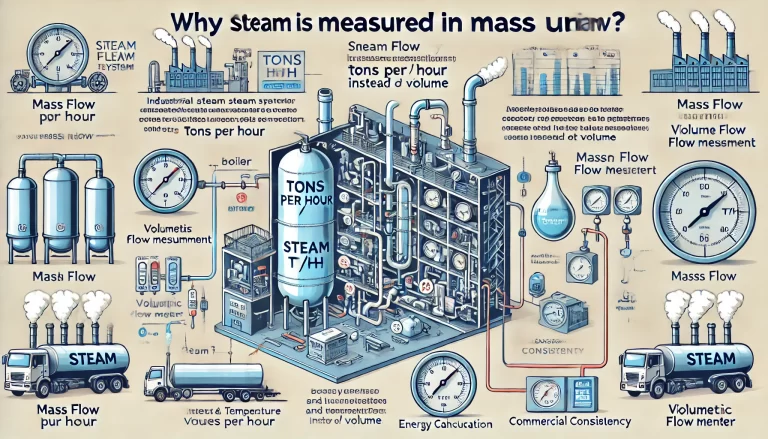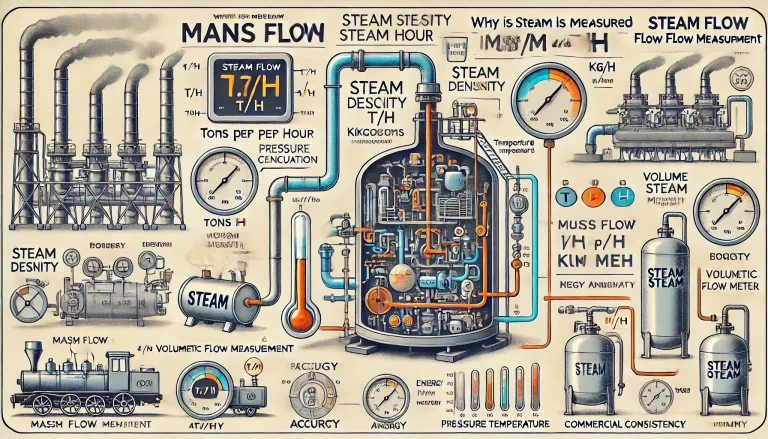Steam is commonly measured using mass units such as tons per hour (t/h) or kilograms per hour (kg/h), rather than volume units. This approach provides several advantages, ensuring more accurate measurement and practical application in engineering and commerce. The primary reasons for using mass units for steam measurement are discussed below.
1. The Significant Influence of Temperature and Pressure on Steam Density
Steam, being a gas, exhibits density variations that are highly sensitive to changes in temperature and pressure. Under different operating conditions, the volumetric flow rate can fluctuate significantly due to these variations, leading to potential measurement inaccuracies.
In contrast, mass flow measurement remains unaffected by temperature and pressure changes, offering a more stable and reliable representation of the actual quantity of steam. This stability is crucial in processes where precise control over steam input is required.
2. Facilitation of Engineering Calculations and Commercial Transactions
Using mass units, such as tons or kilograms, provides a straightforward and intuitive way to quantify steam, which simplifies engineering calculations and financial transactions.
In commercial trade, mass flow is the preferred measurement unit because it is more standardized, easier to comprehend, and less prone to discrepancies caused by fluctuating environmental conditions. Additionally, mass-based billing ensures fair and consistent transactions, avoiding disputes related to varying densities due to changing pressure or temperature.

3. The Necessity of Temperature and Pressure Compensation
Since steam density is closely related to temperature and pressure, accurate volumetric flow measurement requires compensation for these variables. In practical applications, temperature and pressure sensors are employed to continuously monitor steam conditions, allowing for real-time density corrections to obtain accurate mass flow values.
For example, in the case of saturated steam, there is a direct correlation between pressure and temperature, making compensation relatively straightforward. However, with superheated steam, both temperature and pressure must be considered simultaneously, adding complexity to volumetric measurement.
4. Indirect Representation of Energy Content
The fundamental purpose of steam usage is to provide thermal energy. Measuring the energy content of steam requires knowledge of its specific enthalpy, which represents the heat energy per unit mass.
Mass flow measurement provides an efficient and established method to indirectly estimate the thermal energy delivered, as the total energy can be calculated using the formula:
Q=m˙⋅h
Where:
- Q= Heat energy (kJ or kWh),
- m= Mass flow rate (kg/h or t/h),
- h= Specific enthalpy (kJ/kg).
This approach is widely used in industrial applications to track energy consumption and optimize system efficiency.
Why Not Use Mass Flow Meters Directly for Steam Measurement?
Given the advantages of mass flow measurement, one might wonder why mass flow meters are not always used directly. The reason lies in the complex nature of steam properties.
Steam density fluctuates with temperature and pressure, making direct mass flow measurement challenging and costly. In practical applications, volumetric flow meters (such as orifice plates, vortex flow meters, or differential pressure flow meters) are commonly used. These devices measure volume flow and, with the help of temperature and pressure compensation, calculate the corresponding mass flow.
For saturated steam, where pressure and temperature have a fixed relationship, compensation is relatively simple. However, for superheated steam, precise measurement requires simultaneous consideration of temperature and pressure, adding complexity to the instrumentation and data processing.

Conclusion
In summary, steam is typically measured in mass units rather than volume units due to the following advantages:
- Improved accuracy and stability, as mass flow is unaffected by pressure and temperature variations.
- Simplified engineering and commercial transactions, enabling consistent calculations and fair trade practices.
- Ease of temperature and pressure compensation, ensuring reliable measurement across different operating conditions.
- Accurate representation of thermal energy, making mass flow the preferred unit in energy management systems.
By using mass units, industries can achieve greater consistency, accuracy, and efficiency in their steam-related processes, ensuring optimal performance and cost-effectiveness.
